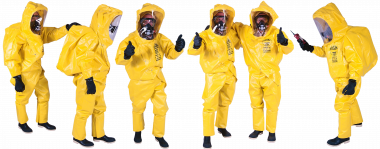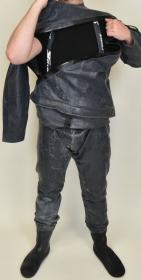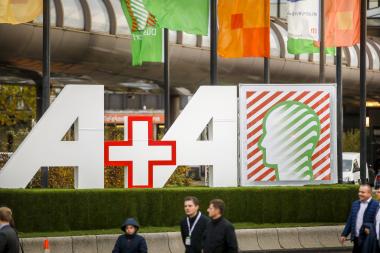DITF: Newly developed concept for chemical protective suits
A newly developed concept for chemical protective suits is designed to make use more comfortable and safer for the user. New materials and an improved design increase wearer comfort. The integration of sensor technology enables the monitoring of vital functions.
In the event of hazards from chemical, biological or radioactive substances, chemical protective suits (CSA) protect people from physical contact. CSAs consist of breathing apparatus, head protection, carrying frames and the suit itself. This adds up to a weight of around 25 kg. The construction of a multi-coated fabric makes the CSA stiff and provides for considerable restrictions in freedom of movement. As a result, the emergency forces are exposed to significant physical stress. For this reason, the total deployment time when using a CSA is limited to 30 minutes.
In a joint project with various companies, institutes and professional fire departments, work is currently underway to completely redesign both the textile material composite and the hard components and connecting elements between the two. The goal is a so-called "AgiCSA", which offers significantly more comfort for the emergency forces due to its lighter and more flexible construction. The DITF subproject focuses on the development of a more individually adaptable, body-hugging suit on the one hand, and on the integration of sensors that serve the online monitoring of important body functions of the emergency personnel on the other.
At the beginning of the project, the DITF received support from the Esslingen Fire Department. They provided a complete CSA that is used as standard today. This could be tested at the DITF for its wearing properties. The researchers in Denkendorf are investigating where there is a need for optimization to improve ergonomic wearing comfort.
The aim is to construct a chemical- and gas-tight suit that fits relatively closely to the body. It quickly became clear that it was necessary to move away from the previous concept of using woven fabrics as the basic textile material and think in terms of elastic knitted fabrics. In implementing this idea, the researchers were helped by recent developments in the field of knitted fabric technology in the form of spacer fabrics. By using spacer textiles, many of the requirements placed on the base substrate can be met very well.
Spacer textiles have a voluminous, elastic structure. From a wide range of usable fiber types and three-dimensional design features, a 3 mm thick spacer textile made of a polyester pile yarn and a flame-retardant fiber blend of aramid and viscose was selected for the new CSA. This textile is coated on both sides with fluorinated or butyl rubber. This gives the textile a barrier function that prevents the penetration of toxic liquids and gases. The coating is applied to the finished suit by a newly developed spraying process. The advantage of this process over the conventional coating process is that the desired elasticity of the suit is retained.
Another innovation is the integration of a diagonal zipper. This makes it easier to put on and take off the suit. Whereas this was previously only possible with the help of another person, the new suit can in principle be put on by the emergency responder alone. The new design is modeled on modern dry suits with diagonal, gas-tight zippers.
The new AgiSCA also features integrated sensors that allow the transmission and monitoring of the vital and environmental data of the emergency worker as well as their location via GPS data. These additional functions significantly enhance operational safety.
For the hard components, i.e. the helmet and the backpack for the compressed air supply, lightweight carbon fiber-reinforced composite materials from Wings and More GmbH & Co. KG are used.
The first demonstrators are available and are available to the project partners for testing purposes. The combination of current textile technology, lightweight construction concepts and IT integration in textiles has led to a comprehensive improvement of a high-tech product in this project.
BMBF project "Development of a chemical protection suit with increased mobility for more efficient operational concepts through increased autonomy of the emergency forces (AgiCSA)".
The project addresses the objectives of the Federal Government's framework program "Research for Civil Security 2018-2023 and the funding measure "SME-innovative: Research for Civil Security" of July 3, 2018.
DITF Deutsche Institute für Textil- und Faserforschung




